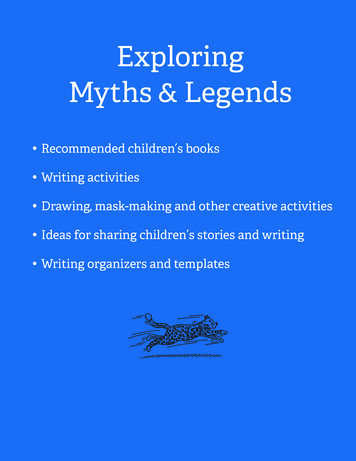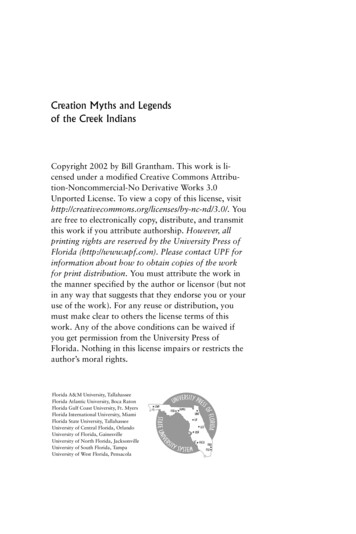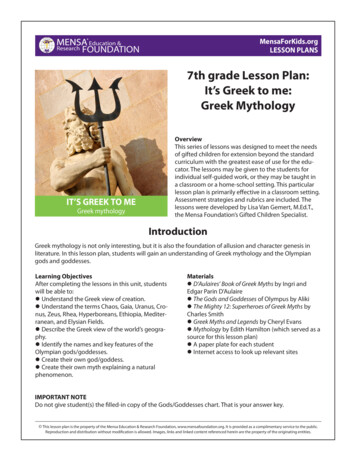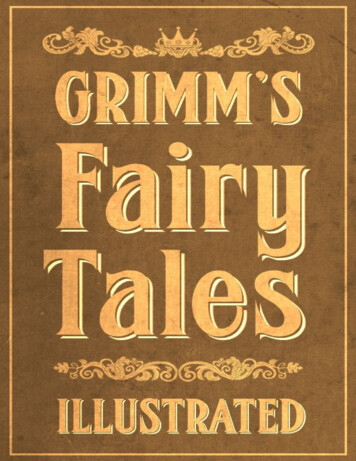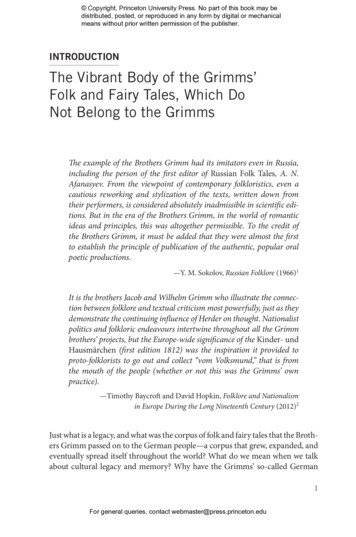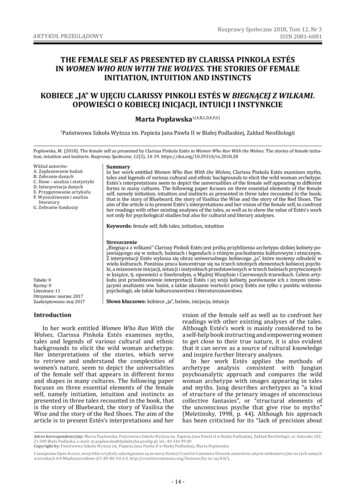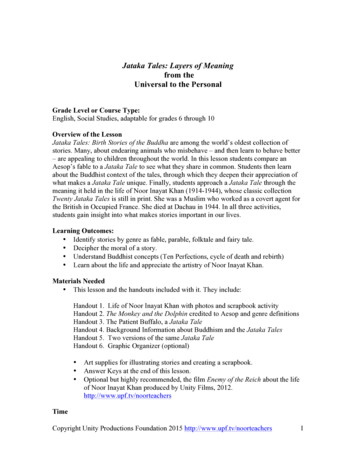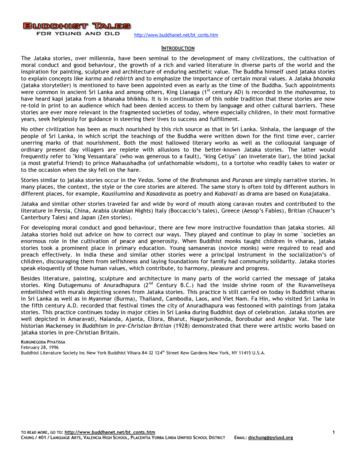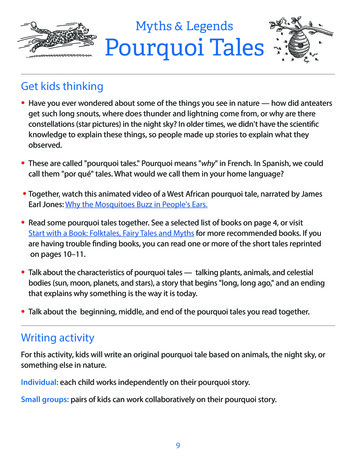
Transcription
Myths & LegendsPourquoi TalesGet kids thinking Have you ever wondered about some of the things you see in nature — how did anteatersget such long snouts, where does thunder and lightning come from, or why are thereconstellations (star pictures) in the night sky? In older times, we didn't have the scientificknowledge to explain these things, so people made up stories to explain what theyobserved. These are called "pourquoi tales." Pourquoi means "why" in French. In Spanish, we couldcall them "por qué" tales. What would we call them in your home language? Together, watch this animated video of a West African pourquoi tale, narrated by JamesEarl Jones: Why the Mosquitoes Buzz in People's Ears. Read some pourquoi tales together. See a selected list of books on page 4, or visitStart with a Book: Folktales, Fairy Tales and Myths for more recommended books. If youare having trouble finding books, you can read one or more of the short tales reprintedon pages 10–11. Talk about the characteristics of pourquoi tales — talking plants, animals, and celestialbodies (sun, moon, planets, and stars), a story that begins "long, long ago," and an endingthat explains why something is the way it is today. Talk about the beginning, middle, and end of the pourquoi tales you read together.Writing activityFor this activity, kids will write an original pourquoi tale based on animals, the night sky, orsomething else in nature.Individual: each child works independently on their pourquoi story.Small groups: pairs of kids can work collaboratively on their pourquoi story.9
Myths & LegendsPourquoi TalesHow the Leopard Got His Spots (A South African Story)A long, long time ago, Leopard was the plain, solid brown-yellow color of the desert. He wasso plain he was almost invisible against the brown-yellow desert. When he headed out tohunt, Giraffe and Zebra and the other animals didn't know which way to jump. To escapeLeopard's appetite, Giraffe and Zebra headed into the great shadowy forest. When Leopardtried to follow them, he stood out like a bright-yellow sunflower against a dark fence. Hecould not hunt at all. Giraffe and Zebra saw yellow Leopard right away, and ran off deeperinto the forest. Leopard had to do something. He asked his human friend to help him. Sothe Man carefully dipped his five fingertips in black ink and painted spots all over Leopard'sfur. Now Leopard could blend into the shadows, and once again he became a great andpowerful hunter!Why the Sun and Moon Live in the Sky (A Zuni Legend)A long time ago, there was no day. It was always dark and always summer. This was becausethe Kachina, a very powerful people, had stolen the Sun and the Moon and locked themaway in a box. In the dim light, Coyote and Eagle, two friends, wandered the desert. Coyoteand Eagle had always hunted together, but Coyote could not hunt anymore because hecould not see at night. Coyote suggested that they go to find the Sun and Moon and makethem light up the world. Eagle was worried. He reminded Coyote that the Sun and Moonwere very strong, and it was dangerous to try to trick them. In the end, Eagle agreed to helpCoyote. While the Kachina were sleeping, Coyote and Eagle crept into their village, stole theSun and Moon, and headed into the hills. Coyote told Eagle that he wanted to open the boxcontaining the Sun and the Moon. Eagle said no. They must wait until after their travels andopen it with their eyes closed. Coyote grumbled. He couldn't wait to see what was in thatbox. Finally he grew so curious that he threw it open. The light of the Sun was so bright itblinded Coyote's eyes. The Sun and Moon laughed and flew far away, up into the sky wherethey are today.10
Myths & LegendsPourquoi TalesWhy Mosquitoes Buzz in People's Ears (A West African Tale)A long, long time ago, Mosquitoes didn't buzz, they talked. And talked and talked and talked.One day, Mosquito was talking to Iguana, telling him about his vacation, about every minuteof his vacation. Mosquito would not let Iguana say one word. Iguana was so annoyed thathe walked away, leaving Mosquito still talking. Iguana grumbled and waved her tail. She wasstill grumbling when she passed her friend Snake, and forgot all about saying hello. Snake'sfeelings were hurt. He felt so sad that he slithered down a rabbit hole. "Help," yelled Rabbit asshe scurried out of the hole, terrified of Snake. "What's wrong?" cawed Crow as he saw Rabbitracing. Danger must be near. "Run for your lives!" cawed Crow. Monkey heard Crow's warningand took off through the treetops, leaping branch to branch. When Monkey landed on Owl'sbranch, high up in a leafy tree, Owl's nest tipped off the branch and fell to the ground,breaking Owl's eggs. Owl was heartbroken, so much that she didn't hoot for the sun to comeup. The whole jungle was in darkness. Everyone was mad at Mosquito. Finally Owl hootedfor the sun to come up and when it did, Mosquito lost his voice. All he could do was buzz ineveryone's ears: "Zzzzzz! Is everyone still mad at me?"11
Myths & LegendsPourquoi TalesSupplies Pencils, pens, and art supplies: colored pencils, markers, crayons Index card (1 per child) Drawing paper or construction paper: 8-1/2 x 11 or larger (2 sheets per child) Construction paper or cardboard, felt, yarn, and other decorative materials (optional) Scotch tape, scissors, school glue (optional) Story maps (included in packet)Let's get startedTogether, take a walk outside and tell the kids to think about what animal, plant, or otherobservation about nature they want to write about. Encourage the kids to jot downobservations and ideas on their index cards. Younger kids who aren't yet writing cansketch what they see.If an outdoor walk is not possible or doesn't generate enough ideas, you can instead havea group brainstorming session and come up with a list of interesting things in nature. Makesure each child chooses something to write about!Here are some things to think about: What is your pourquoi tale going to explain? Who are your main characters? Where does your story take place? What is the main problem of the story? How is it solved? What happened as a result of this solution? (This is where your question is answered) Is there a lesson or moral taught through the story?12
Myths & LegendsPourquoi TalesRemind the kids that every pourquoi tale begins with a question, such as "why domosquitoes buzz in people's ears?" or "how did the leopard get his spots?"Next, give each child a copy of the story map found in this packet. Tell the kids to think aboutand write down the question they are going to answer in their story. If kids are still stuck anddon't know what to write about, you can use the suggested topic ideas on page 15 — theyare already in the form of a question.The story map has guiding questions to help kids work out the parts of their tales. Let thekids know that they can let their imaginations run wild as they think about why that animal,plant, or other natural thing came to be or look the way it is — and how the action in thestory is described.Show the kids how to use the beginning-middle-end story map in this packet to write thedraft of their pourquoi tales. Remind the kids to use descriptive words to bring their storiesto life. The last sentence in the story should begin with "And that's why ."With younger kids, you may need to guide them through the whole process, and they cantell you their ideas as you write their story down.Once the kids are satisfied with their stories, tell them to write out a final, polished versionon a fresh sheet of paper.Option: We've provided a set of decorative templates that kids can use for the final versionsof their pourquoi tales. They are included at the end of this packet.Encourage kids to include a drawing with their pourquoi tales; these can be embellishedwith collage materials if they like. Don't forget to add a title!Try this!Comic Strip: Some kids love comics and may even be talented comic strip artists. Tap intothat interest by offering this alternative format for the pourquoi tale. Kids should still gothrough the thinking process with their story maps, but in addition to written text they canalso sketch out their illustrations. Use plain paper or the comic strip template in this packet.13
Myths & LegendsPourquoi TalesMask makingStorytellers and actors from all over the worldhave used masks for thousands of years to helptell their stories. Invite kids to make masks ofthe characters from their pourquoi tales. Youcan use ordinary household items or recyclablematerials, or make one with papier maché.Find directions at the links below: Milk jugs Cardboard Egg cartons Paper plates Paper bags Papier machéSharing our workOnce the pourquoi tales are finished, gather everyone together in a circle to read the storiesout loud. Kids can be as dramatic as they like in sharing their stories. Kids can also chooseto memorize their stories and present them without notes — in keeping with the oralstorytelling tradition.Tell kids to share their pourquoi tale with family and friends. They can invite listeners byasking, for example “Do you know why the raccoon wears a mask?”Try this!Record It: Help kids to record their tall tales on a smart phone (audio or video) and sharewith their extended families!For more reading, writing, and learning resources, visit www.StartWithABook.org14
Myths & LegendsPourquoi TalesTopic ideasIf kids are having a difficult time thinking about a topic for their pourquoi stories, here aresome ideas to jumpstart imaginations. Why does the moon change shape? Where does thunder come from? Where does lightning come from? Why do leaves change color in the fall? Why do roses have thorns? Why do squirrels bury their acorns? Why do caterpillars change into butterflies? Why do bees make honey? Why do snakes have no legs? Why does an owl hunt at night? Why does a seashell hold the roar of the ocean? Why is the ocean salty? Why does the raccoon wear a mask? Why is the raven black? Why do male peacocks have such colorful feathers? Why do turtles have a shell on their back? How did lizards learn to climb walls? How did porcupines get their quills?15
Pourquoi Tales: Story MapWho, what, why, when, and how?Time and place (setting)What does your story help to explain? That's the "why" or "how" question!Who are the "characters" in your story?(Plants, animals, or the moon and stars can all be characters)Describe the problem(Why did the feature change? Or if it's something new in nature, why was it created?)The solution(The answer to your "why" or "how" question)
Pourquoi Tales: Story MapBeginning, Middle, EndAt the beginning:Then:
Pourquoi Tales: Story MapBeginning, Middle, EndFinally:And that's why .
My Pourquoi Tale
My Pourquoi Tale
are having trouble finding books, you can read one or more of the short tales reprinted on pages 10–11. Talk about the characteristics of pourquoi tales — talking plants, animals, and celestial bodies (sun, moon, planets, and st
